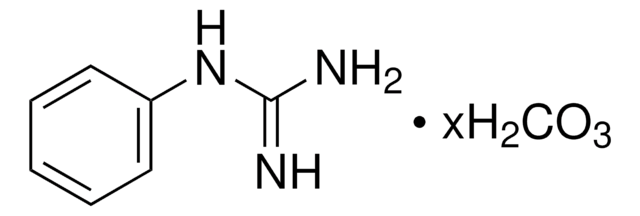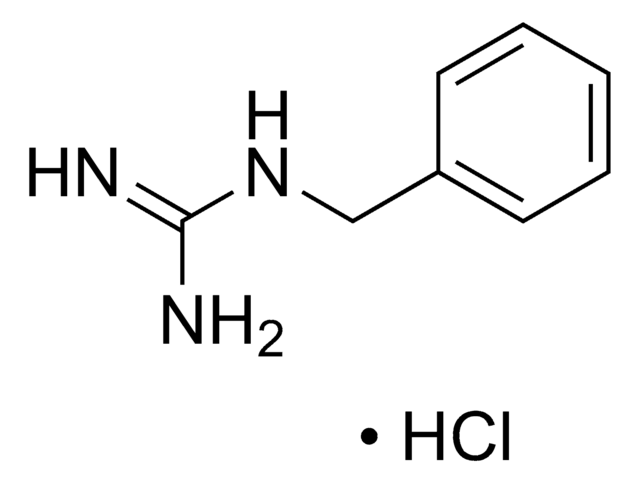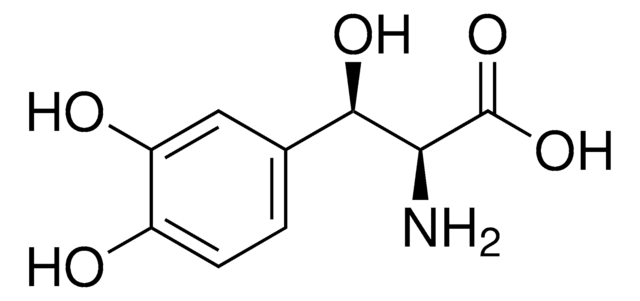All Photos(1)
About This Item
Linear Formula:
CH5N3O · 1/2H2SO4
CAS Number:
Molecular Weight:
124.11
EC Number:
MDL number:
UNSPSC Code:
12352202
PubChem Substance ID:
NACRES:
NA.77
Recommended Products
biological source
synthetic (organic)
Assay
≥98% (TLC)
form
powder
solubility
water: 25 mg/mL, clear, colorless
storage temp.
2-8°C
SMILES string
NC(=N)NO.NC(=N)NO.OS(O)(=O)=O
InChI
1S/2CH5N3O.H2O4S/c2*2-1(3)4-5;1-5(2,3)4/h2*5H,(H4,2,3,4);(H2,1,2,3,4)
InChI key
MTGDDPZRXSDPFH-UHFFFAOYSA-N
Biochem/physiol Actions
An early antitumor agent. Oxidation results in release of NO, and formation of other reactive oxygen species, including peroxynitrite and peroxyl radicals. Reacts with NO to form an adduct which is a potent and stable vasodilator.
Storage Class Code
11 - Combustible Solids
WGK
WGK 3
Flash Point(F)
Not applicable
Flash Point(C)
Not applicable
Personal Protective Equipment
dust mask type N95 (US), Eyeshields, Gloves
Certificates of Analysis (COA)
Search for Certificates of Analysis (COA) by entering the products Lot/Batch Number. Lot and Batch Numbers can be found on a product’s label following the words ‘Lot’ or ‘Batch’.
Already Own This Product?
Find documentation for the products that you have recently purchased in the Document Library.
Tingwei Cai et al.
Bioorganic & medicinal chemistry letters, 12(11), 1507-1510 (2002-05-29)
The electrochemical properties of a series of N-substituted-N'-hydroxyguanidines were studied. Two oxidation potentials of each compound were obtained by cyclic voltammetry. The E(ox1) values were from 0.51 to 0.62V, while the E(ox2) values were from 1.14 to 1.81V in acetonitrile
David Lefèvre-Groboillot et al.
Biochemistry, 42(13), 3858-3867 (2003-04-02)
The interaction of various N-alkyl- and N-aryl-N'-hydroxyguanidines with recombinant NOS containing or not containing tetrahydrobiopterin (BH(4)) was studied by visible, electronic paramagnetic resonance (EPR), and resonance Raman (RR) spectroscopy. N-Hydroxyguanidines interact with the oxygenase domain of BH(4)-free inducible NOS (BH(4)-free
S A Everett et al.
Free radical biology & medicine, 24(1), 1-10 (1998-01-22)
The oxidative denitrification of the antitumour agent hydroxyguanidine (HOG) has been investigated by radiolysis methods and EPR spectroscopy. The azide radical (N3.), a model one-electron oxidant, reacts with HOG with the rate constant 5.1 x 10(9) dm3 mol(-1) s(-1) to
Oxidation of N-hydroxyguanidines by cytochromes P450 and NO-synthases and formation of nitric oxide.
Daniel Mansuy et al.
Drug metabolism reviews, 34(3), 593-606 (2002-09-07)
Microsomal cytochromes P450 and tetrahydrobiopterin (BH4) free-NOS II catalyze the oxidation of N-hydroxyguanidines by NADPH and O2 with formation of nitrogen oxides including NO. These reactions are not selective in terms of substrates, as they occur on most N-hydroxyguanidines, and
Alycen Pond Nigro et al.
Archives of biochemistry and biophysics, 500(1), 66-73 (2010-03-30)
Yeast cytochrome c peroxidase was used to construct a model for the reactions catalyzed by the second cycle of nitric oxide synthase. The R48A/W191F mutant introduced a binding site for N-hydroxyguanidine near the distal heme face and removed the redox
Our team of scientists has experience in all areas of research including Life Science, Material Science, Chemical Synthesis, Chromatography, Analytical and many others.
Contact Technical Service








